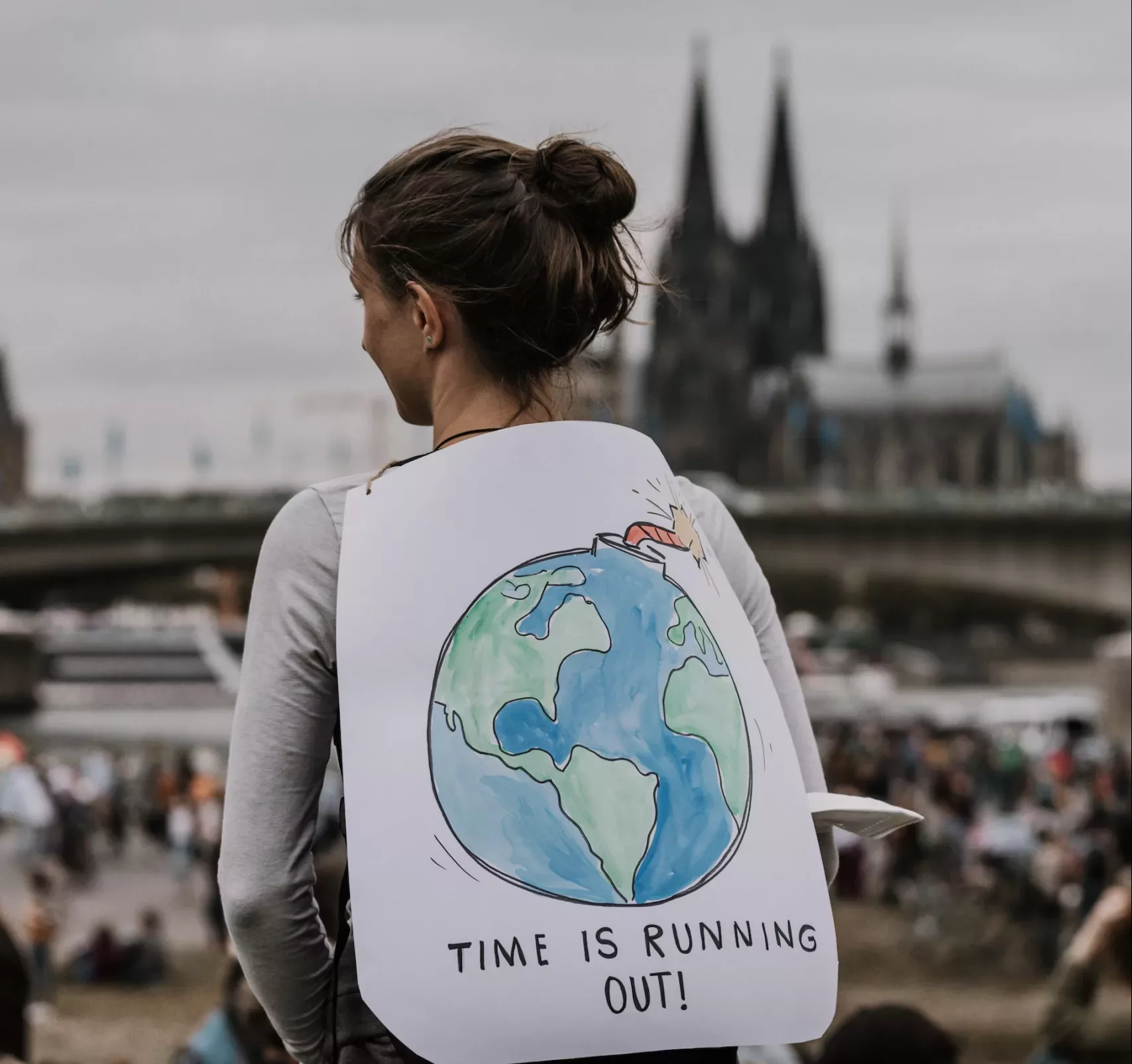An activist protests inaction on climate change in Cologne, Germany. Via Unsplash
The most recent IPCC report suggest that global average temperatures due to fossil fuel emissions are likely to surpass 1.5°C in the next couple of decades.
Increased greenhouse gases in the atmosphere will cause not only global average temperature increases, but precipitation increases, decreases in sea ice cover, sea level rise, ocean acidification, heat stress and other negative impacts upon crops, and increases in extreme weather and climate-related events, species extinctions, and other damages.
Given that reducing fossil fuel emissions in order to avoid undesirable impacts from climate change requires transformation of technological systems on scales that are unprecedented, geoengineering, defined by a Royal Society report as ‘the deliberate large scale intervention in the Earth’s climate system in order to moderate global warming’, has attracted attention over recent years as a possible solution to avert dangerous anthropogenic climate change (see: stratospheric sulphur injections; various pathways for removing carbon dioxide.)
Geoengineering schemes can be fit into two categories: solar radiation management (SRM) techniques and carbon dioxide removal (CDR) techniques. However, there is still debate about what terminology should be used. For example, other categories are possible, including radiation management (RM), which encompasses not only SRM technologies but also those proposals seeking to enhance outgoing long-wave radiation, such as cirrus stripping. There are also methods that seek to remove greenhouse gases other than CO2 from the atmosphere (greenhouse gas removal, ‘GHGR’), as well as debate on the term geoengineering itself which brings together many entirely separate technologies with different climatic and social issues. However, we will stick to using the terminologies CDR and SRM.
Examples of CDR techniques include afforestation, using biomass or biofuels that are derived via carbon sequestration, biochar, enhanced weathering, and ocean fertilisation. These technologies can be very varied in their approaches: for example, carbon sequestration can involve capturing and storing relatively pure streams of CO2 from industrial sources, and transported to long-term storage locations, whilst ocean fertilisation involves proposals such as iron fertilisation which could cause an increase in phytoplankton that convert the CO2 from the atmosphere dissolved into the ocean into carbohydrate. However, such methods could result in ‘nutrient robbing’, a process where excess nutrients used in one location are then unavailable for normal productivity downstream in the ecosystem.
As CDR methods generally aim to reduce the amount of carbon dioxide in the atmosphere, they deal directly with the source of increased radiative forcing (the change in energy flux in the atmosphere caused by natural or anthropogenic factors, measured in Watts per metre squared) and climate change. They may also address other effects of climate change, such as ocean acidity, which SRM techniques alone cannot. When considering strategies for avoiding dangerous climate change, it is important to note that CDR techniques act across much longer time-scales. While CDR techniques may therefore seem the most appropriate, modelling research actually suggests that rising SSTs are a greater threat for tropical coral reefs than ocean acidification, meaning CDR may be less useful to help maintain coral reef habitats in the near-term.
Whilst carbon dioxide removal can be argued to be essential if the world is to achieve its universally agreed Sustainable Development Goals (SDGs), the size of industry required, cost and problems with scalability from the laboratory to the real world, mean that they are not ready for implementation as a viable alternative to mitigation and adaptation. The time taken to develop these technologies may be very long, such that sufficient economic and ecological damage is likely to occur during their development, as well as creating new problems such a phase down of an enterprise that would require billions to trillions of dollars per year, after having operated for approximately a century or so.
However, since a large amount of emitted carbon dioxide remains in the atmosphere on the time scale of centuries to millennia, the Earth’s global averaged temperature relative to pre-industrial will also stay high for centuries to millennia if that CO2 remains in the atmosphere. Rather than providing a solution to climate change over the short or medium timescale by tackling emissions head on, CDR techniques can arguably therefore be best thought of as something that will deal with, and be necessary to bring carbon dioxide levels back to pre-industrial, ‘natural’ levels. At very least, it is unlikely that CDR techniques will be able to match or exceed the rate of emissions soon so as to drawdown CO2 to safe levels, and the noble goal of CDR techniques do not remove the necessity of substantially reducing emissions.
SRM techniques aim to reduce the global mean temperature by changing the Earth’s global annual mean energy budget. They work by reflecting a small fraction of the incoming solar radiation back to space, and they are, in contrast to CDR, extremely fast-acting. Hence, SRM techniques have been argued to possess a particular advantage over CDR methods in their ability to deal rapidly with climate emergencies. They are also much cheaper to implement than CDR technologies.
Examples of SRM techniques include increasing the surface reflectivity of the planet, whether through painting roofs or placing reflective materials over large areas of desert, enhancement of marine cloud reflectivity, injecting sulphate aerosols into the lower stratosphere, and placing shields or deflectors in space.
Some SRM techniques, such as space mirrors, sound frankly futuristic. Other schemes, such as roof painting, have been shown to have a negligible globally averaged climate effect. The first suggestion of SRM techniques was made by Mikhail Budyko in 1974 (published in an English translation in 1977).
For many decades the notion was therefore effectively ignored. Then, in 2006, Nobel Prize-winning atmospheric chemist Paul Crutzen suggested that injecting sulphate aerosols into the stratosphere was perhaps worth more consideration; whilst not without negative consequences, maybe it didn’t deserve to be dismissed outright.
It has long been known that volcanic eruptions can exert a cooling influence on the climate. Volcanic eruptions, if sufficiently large, emit sulphate gas. If this makes its way into the stratosphere, either by direct “injection” (i.e., through the explosivity of the eruption itself) or with the aid of climate phenomena, it is converted into sulphate aerosol particles. Too high to be released as rain, these stratospheric sulphate aerosols have the potential to remain in the atmosphere for many years, and reflect a portion of the incoming solar radiation. This results in a cooling of the atmosphere below; for example, the Pinatubo eruption of 1991, the second largest eruption of the 20th century, kept global temperatures about 0.5°C below average for over a year afterwards.
With the existence of these natural analogues, such as volcanic eruptions (that already inject sulphate gas into the stratosphere if large enough), and noting that industrial emissions of sulphate aerosols already cause a small offsetting of a fraction of the anthropogenic increase in greenhouse gas warming, Crutzen wrote his now famous article. Crutzen considered that these aerosols emitted by industry (known to 500,000 premature deaths per year worldwide cause air pollution) if emitted into the stratosphere, would have a similar cooling effect, whilst substantially reducing the harmful effects of these aerosols as regards air pollution.
Since Crutzen’s article, SRM techniques and are now being investigated thoroughly (e.g. 1, 2, 3, 4, 5) and have generated a substantial amount of public attention. Stratospheric aerosol injection is considered the leading contender with SRM proposals.
Whilst SRM proposals are cheap, fast acting, and relatively easy to implement, the only possible place for them would be a short term ‘strategy’. However, they pose an enormous number of very serious problems that are already known. Research on most of the world’s major climate models has shown that these models are capable of reproducing some, but not all, of the climate effects of stratospheric aerosols caused by substantial volcanic eruptions. Though our ability to predict the side effects of geoengineering is far from perfect, we do know that there are many serious (and essentially necessary) potential side effects of sulphate aerosol geoengineering. These include physical effects in terms of climate impacts, as well as socio-political and economic ones and climate change damages that cannot be addressed through SRM techniques.
Sulphate aerosol geoengineering would have substantial negative impacts. These include not only direct effects like a reduction in protective stratospheric ozone, and impacts to the hydrological cycle, but indirect consequences, such as attenuating global agricultural damage from climate change. Furthermore, this form of geoengineering is unable to offset how climate change impacts some of the same phenomena, like its own influence on the hydrological system.
Governance issues surrounding SRM technologies are enormously complex. If a few powerful nations decided to start deploying SRM, and it had side effects on another nation’s crops, ecology, hydrology, or wealth, it has been suggested that geoengineering could spark wars. SRM may necessitate autocratic global governance, and the fact that motivations for SRM will always be plural and unstable may make policy reversals inevitable. If a geoengineering programme was stopped, as would therefore be likely, all the warming that would have occurred in that time that was masked by SRM would occur rapidly, within the space of a few years. As the climate then “jumps” up to its unmasked temperature level, this rapid rise and impacts would arguably be far worse than that of climate change alone.
In these cases, SRM cannot be considered only a positive, as its net impact would to increase warming in the long term. SRM technologies can therefore be considered capable of causing catastrophic global risks. The benefits of SRM technologies would have to be enormous to justify their use, and the certainty and ability to govern them is currently too far beyond our means to be considered as a serious climate strategy in the present.
With the only possible option for SRM being a short term implementation, it brings too many complications, side effects and uncertainties to warrant serious attention as a strategy for ameliorating climate change. Understanding the cost scales and time for serious CDR methods to be deployed, CDR methods may be useful in scenarios where we have already been able to drop emissions.
Overall, I would argue that SRM technologies should not only be safely ignored as strategies for combatting global warming, but that they so many negatives so as to be essentially outright dangerous. The main focus should be on mitigation and adaptation. CDR methods are technologies not without their own set of risks and drawbacks, yet I would argue if they safe (which is not guaranteed, for example with ocean fertilisation) then they are essential. The quicker they can be safely developed, the more CO2 that can be withdrawn from the atmosphere. Ideally this would be quick enough to help with ongoing emissions, but this is highly unlikely.
At any rate, such technologies will be necessary after CO2 emissions have been reduced substantially due to the long lifetime of CO2 in the atmosphere. For anyone interested in the current state of CDR research or with a desire to get involved, “The State of Carbon Dioxide Removal—A global, independent scientific assessment of Carbon Dioxide Removal” may be useful to begin their readings and explore further technologies that could play a large part in the climate crisis.





